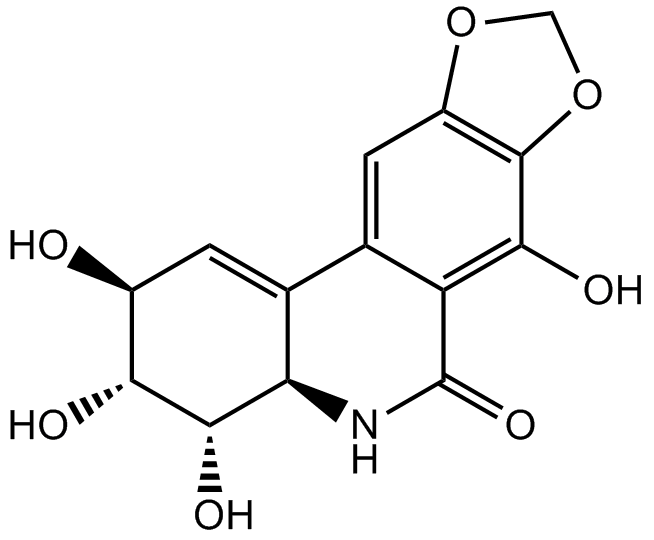Narciclasine (Synonyms: (+)-Lycoricidinol, (+)-Narciclasine) |
| Catalog No.GC12491 |
A plant growth regulator with anticancer activity
Products are for research use only. Not for human use. We do not sell to patients.

Cas No.: 29477-83-6
Sample solution is provided at 25 µL, 10mM.
Narciclasine
Description:
IC50: The mean IC50 of about 50 nmol/L calculated on the 6 human glioblastoma multiforme was similar to the value previously reported for 6 carcinoma cell lines and consistent with National Cancer Institute data, which also reveal a mean IC50 value of 47 nmol/L for the compound across a panel of 60 cancer cell lines [1].
Narciclasine is a toxic alkaloid found in various Amaryllidaceae species, modulatting the Rho/ROCK/LIM kinase/cofilin pathway, stimulating RhoA activation and inducing actin polymerization. The cytostatic activity of Narciclasine involves the impairment of actin cytoskeleton organization by targeting GTPases, including RhoA and the elongation factor eEF1A. Thus, Narciclasine is a potentially promising agent for the treatment of primary brain cancers and various brain metastases.
In vitro: In a MM46 cell in-vitro study, authors examined the inhibitory activities of Amaryllidaceae alkaloids, namely, lycoricidinol (narciclasine), hippeastrine and ungerine against the cytotoxicity of calprotectin. It was found that lycoricidinol (narciclasine) inhibited calprotectin-induced cytotoxicity at more than 10-fold lower concentration (IC50=0.001-0.01 μ/ml) than lycorine, while the effects of the latter two alkaloids were very weak [2].
In vivo: In an in-vivo study, the authors checked the prophylactic effect of lycorine and lycoricidinol (narciclasine) on the adjuvant arthritis model in rats. Results showed that lycoricidinol (narciclasine), rather than lycorine, significantly suppressed the degree of swelling of adjuvant-treated as well as untreated feet, suggesting that lycoricidinol (narciclasine) might be a candidate as a the drug having marked suppressive activity for inflammation which might be influenced by calprotectin [2].
Clinical trial: Up to now, Narciclasine is still in the preclinical development stage and are planned to move toward clinical trials in oncology within a 3-4 year period in order to help patients with brain cancers, including gliomas, as well as brain metastases, which was said by Robert Kiss, Ph.D., co-author of the study from the Laboratory of Toxicology at the Institute of Pharmacy at the Université Libre de Bruxelles in Brussels, Belgium.
Reference:
[1] Lefranc F, Sauvage S, Van Goietsenoven G, Mégalizzi V, Lamoral-Theys D, Debeir O, Spiegl-Kreinecker S, Berger W, Mathieu V, Decaestecker C, Kiss R. Narciclasine, a plant growth modulator, activates Rho and stress fibers in glioblastoma cells. Mol Cancer Ther. 2009;8(7):1739-50.
[2] Mikami M, Kitahara M, Kitano M, Ariki Y, Mimaki Y, Sashida Y, Yamazaki M, Yui S. Suppressive activity of lycoricidinol (narciclasine) against cytotoxicity of neutrophil-derived calprotectin, and its suppressive effect on rat adjuvant arthritis model. Biol Pharm Bull. 1999;22(7):674-8.
Average Rating: 5 (Based on Reviews and 30 reference(s) in Google Scholar.)
GLPBIO products are for RESEARCH USE ONLY. Please make sure your review or question is research based.
Required fields are marked with *




















